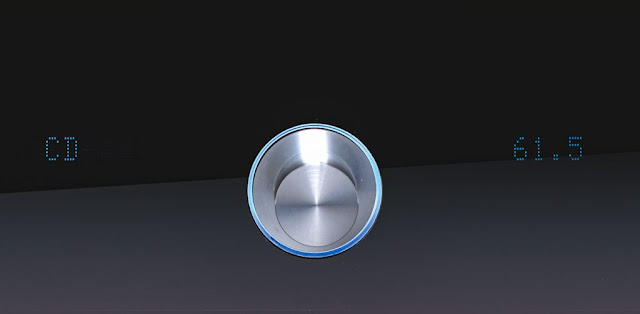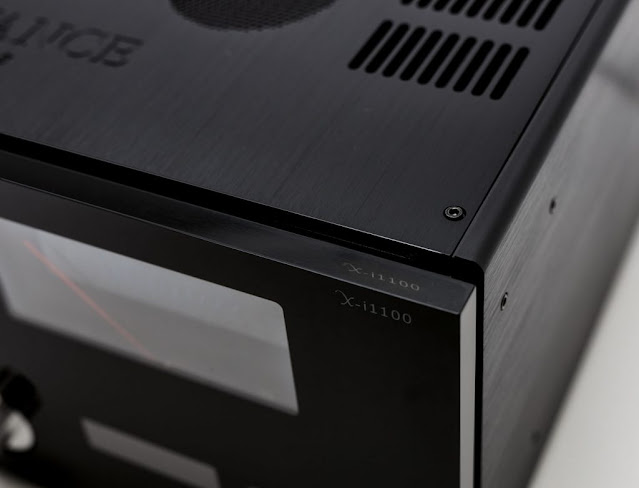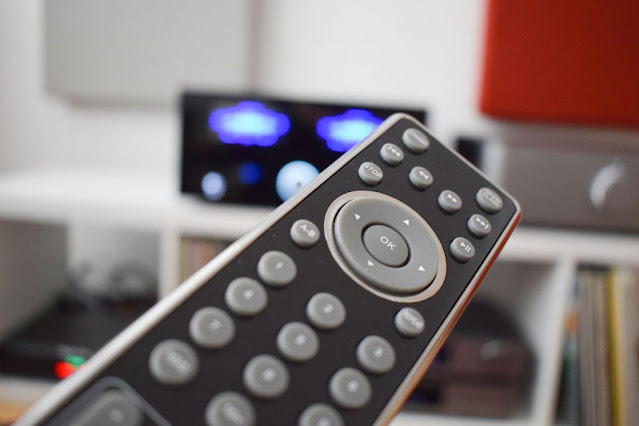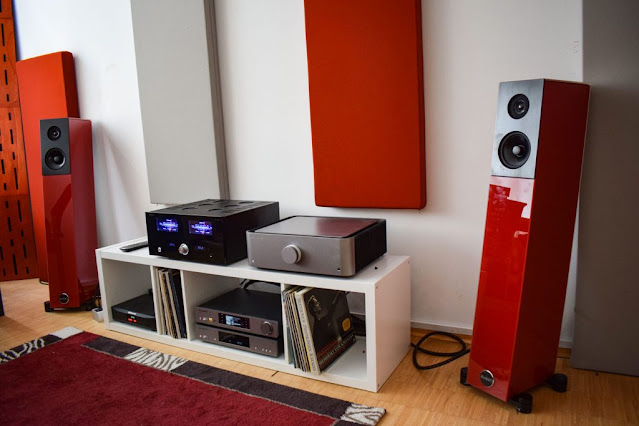Advance Paris Xi 1100 DAC amplifier review
Do we still need VU meters on the front in our detoxified world? Stupid question: The Advance Paris Xi 1100 DAC integrated amplifier has some and I think they could be even bigger. Because they make it clear what he does best: sounding so good, so imperious, so unfiltered.
Can you still call yourself "Paris" in your last name if you live a few kilometers from the city gates? Advance Paris does not have a large assembly line on any of the boulevards. Headquarters is in Brie Comte Robert. That's in the southeast of the capital, around five o'clock. After all: Orly Airport is around the corner. But it takes an hour and twenty minutes to drive to the Champs-Elysées. All no drama. The main thing is that you feel part of one of the most beautiful metropolises in the world.
In Germany, Quadral has taken over the distribution of the electronics. From Hanover it goes into the country. What Quadral is of course hiding: Advance Paris is also a manufacturer of loudspeakers. But they would scratch the core business of the Hanoverians. That's why only the electronics come across the Rhine. Makes sense.
The structure of the Advance Paris Xi 1100
The Advance Paris X-i1100 integrated amplifier from the Classic Line is new to the ranks. I didn't want to meet him alone, couldn't. Because here more than 20 kilos have to be lifted out of the box. Sounds decent for a strength athlete, but we're just wimpy intellectuals, so the two of us lifted him onto the sideboard.
And as soon as the car is in its place, an aesthetic discussion begins. Is that nice now? Or pretentious? Beauty is in the eye of the beholder. But above all, the ClassicLine X-i1100 is a power word. On the bottom left is a small power button, on the bottom right is the socket for the headphones. The combined multifunction rotary knob is significantly thicker in the middle.
Unmissable, however, are two powerful VU meters with twitching pointers and bluish lighting. Someone must have smoked a really big bag. Or he simply followed the product language of Advance Paris. It's amazingly stringent. The fronts shimmer with artificial glass, blue is the identifying mark.
To be honest: I think it's great. This is an integrated amplifier from two worlds. In the arrangement it looks classic, almost old-fashioned. On the other hand, bold in terms of radiance and surfaces. Haute couture and prêt-à-porter together.
Let's turn it around. Holla - someone wants something here. There is hardly any space because of all the docking options. Two possible terminal screws go to the loudspeakers. Output A is already intended as a double for possible bi-wiring. We can get in four times via cinch. Digital equal to eightfold. Right next to it, a real XLR analog input surprises us. Of course there has to be a pre-out. Then there is a switchable cinch output that can either be clicked on to a recorder or subwoofer. And yes - luckily it's also available here - the phono in with grounding screw. Unfortunately, no MC signal can be exploited here, but at least the MM level with an output voltage of 7mV.
But we clearly see the superiority of digital formats. Advance Paris differentiates between the classic D/A converter and the USB connection. At maximum, rates of up to 24 bits and 192 kilohertz are understood. But with a Burr Brown chip PCM1796 for the classics and an XMOS for the USB connection. Sense and purpose: when connected to the computer, its usually weak D/A conversion is completely bypassed.
But what might the Xi 1100 look like from the inside? What brings him to his weight? The question is quickly answered: A total of six chambers share the work, in chamber two there is a huge toroidal transformer, mounted vertically. The display control is housed in chamber one and is fully encapsulated. The preamp is located directly at the inputs. In the middle then the basic structure of the power plant, the output stages themselves are symmetrically on the outside with direct contact to the cooling fins. That looks good. So good that it should actually be permanently displayed under transparent Plexiglas.
What kind of circuit concept are we actually dealing with? This is a mix. It's not uncommon, many engineers have jumped on it: in the small level the Xi 1100 runs as a pure Class A amp, but if the claw and the large access is needed, it leaps into the Class A/B world. 220 watts into 8 ohms or 400 watts into 4 ohms are sufficient in almost all cases.
This is exactly where the wheels in our brain start to turn. What will the good piece probably cost? 7,000 euros? Or even 8,000 euros? Misjudged, all cold. The truth is 3,490 euros. I find that amazingly humane. For the value, the elegance, the overall concept. Now only the sound would have to play along.
This is how the Xi 1100 sounds
Let's start with the unexpected: a vinyl record. How good is the phono board? Right now is the perfect moment to open the wallet. JPC throws out legendary Decca recordings. At the flea market we would pay maybe two euros. But the classics have been emptied. So we go to the vinyl dealer we trust. He wants 20 euros for a first pressing. So with 15 euros for a new edition in 180 grams, we are very good at JPC.
Specifically, the Sibelius Violin Concerto. This is a terrific composition. One could revel, one could dance. We see the sea and the cranes. We are seized by a rush of sound. In the early 1960s, Decca recorded the whole thing with just a few microphones and a wonderful drive. Ruggiero Ricci is holding the violin. The London Symphony Orchestra plays, a Norwegian waves the baton, not a Finn like Sibelius, but still. The early Decca recordingshave so much meat on their ribs. There is no starvation, there is down-to-earthness and violence. That's what makes this recording so unique. And that is exactly what the challenge for an integrated amplifier is. It has to put power into the depths, brute pressure, and create a bright window for the violin and the spatial information.
The Advance Paris was perfect here. That was the ideal mix of longing and concrete access. Great how the double basses occupied the space from the hard right, great how the violin placed a blissful sound in the sweet spot above all. Without question we need the recording, with small question marks we approach the integrated amplifier.
Now we want to know and create a high-res stream in 24 bits and 96 kilohertz, procured from Qobuz. Four names should be enough to get jazz fans rushing into Emphasis: Joshua Redman, Brad Mehldau, Christian McBride and Brian Blade. The quartet presented a recording: "RoundAgain". This is noble jazz in its most beautiful breadth and depth. The saxophone speaks to us, the piano wants to take over, the drums present themselves as servants, the bass as secret rulers.
The masters are so old that they don't need alcohol or LSD. A few cups of tea were probably enough to turn her on. It's great how the Xi 1100 put a stable sound pattern in front of our ears. It was sharp in definition without being harsh. Elegant music meets an elegant amplifier. Here and there the membranes have to tremble, especially when the drums swing out and fire the bass drum in the middle. That has to get to the point, not too soft, but bone dry. That's exactly what the Xi 1100 had.
As a tough competitor, we put on the Edge A from Cambridge Audio . One of our favourites, quite a benchmark in British hi-fi culture. The Cambridge plays softer - or to use the beautiful foreign word: smoother. The instruments have more body. It was clearly more British in spirit. Not centered, but harmonizing. The Advance plays the French contrast program: with more power, more impulsiveness. And: If you are looking for selectivity, you will get more contrast with the Xi 1100.
Another comparison, this time with a Frenchman: The Atoll In 300 is also an excellent DAC amplifier and also one of our references. In terms of tonality, the two French are much more similar. A very open, very direct approach dominates. Nothing is swept under the table, impulses are celebrated, a hit on the snare drum is served almost directly at the next table.
The Atoll proved to be the slightly finer, the Xi 1100 as the slightly more angular, even more powerful, which also develops more power in the low frequency range. Perhaps you can hear the enormously high performance of the Xi 1100 here – as compared to the Cambridge – because 400 watts sinus per channel is already a lot...
Another look at the price tag: 3,490 euros. That's not okay, it's a competitive price. The membranes tremble, the musical flow is just right. Everything tends to be bright. Don't use a tube amp, but a transistor. From the precise-informative side.
Pros and cons on Advance Paris Xi 1100 DAC amplifier review
Pros:
High-Quality DAC: The Advance Paris Xi 1100 features a high-quality digital-to-analog converter (DAC) that can significantly enhance audio quality, especially when playing digital music sources.
Amplification Power: With a powerful amplifier section, the Xi 1100 can drive a wide range of speakers effectively, delivering ample power and ensuring clean, distortion-free sound reproduction.
Versatility: This amplifier is designed to accommodate various input sources, including digital and analog inputs, providing flexibility for users with different audio equipment setups.
Build Quality: Advance Paris is known for its attention to build quality, and the Xi 1100 is no exception. It features sturdy construction and premium components, which contribute to its durability and long-term reliability.
Sound Performance: Users often praise the Xi 1100 for its excellent sound performance, characterized by clarity, detail, and dynamic range, resulting in an immersive listening experience across different music genres.
Cons:
Price: The Advance Paris Xi 1100 DAC amplifier is positioned at a premium price point, which may be prohibitive for some buyers, especially considering the availability of lower-priced alternatives with comparable features.
Complexity: Some users may find the Xi 1100's array of features and settings overwhelming, particularly if they are not familiar with advanced audio equipment. The extensive options for customization may require a learning curve to fully utilize.
Size and Weight: As a high-end amplifier, the Xi 1100 tends to be larger and heavier compared to entry-level or mid-range amplifiers. This may pose challenges in terms of placement and portability, particularly in smaller living spaces.
Heat Dissipation: Given its powerful amplifier section, the Xi 1100 can generate significant heat during operation. Proper ventilation and adequate space around the amplifier are necessary to prevent overheating and ensure optimal performance.
Compatibility: While the Xi 1100 offers a range of input options, some users may find compatibility issues with certain audio devices or formats. It's essential to verify compatibility with your existing equipment before purchasing.
Specifications
Conclusion
A lot comes together here: the crisp sound of a fat transistor amplifier, the high resolution of an ambitious DAC and an amazing amount of stable performance. The X-i1100 can play wonderfully dynamically and neutrally, but also extend its claws at high levels. The music listener can bathe, swim, but also take a cold shower from time to time. The built-in DAC is of the same grandeur. Here, too, there is a lot of joy of playing and a lot of resolution.
With the Xi 1100, Advance Paris has launched an impressive flagship amplifier that is “big” in every respect, but has kept the attached price tag pleasingly small. It has always been the credo of the French to offer as much as possible for as little money as possible. With the Xi 1100 they have implemented this intention particularly well.
























.jpg)



0 Comments